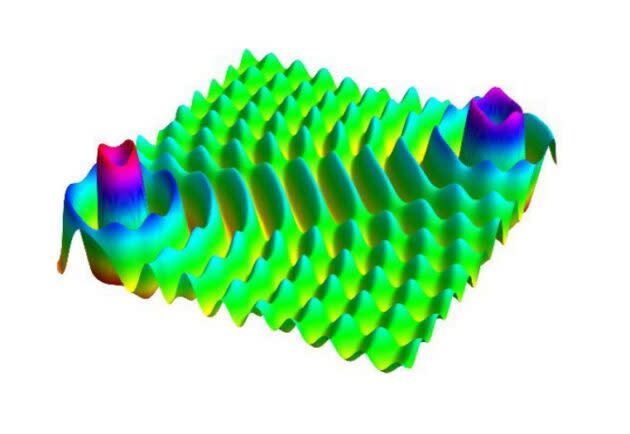
The University of Washington physicist who once ran a crowdfunded experiment on backward causation is now weighing in with a potential solution to one of the longest-running puzzles in quantum mechanics.
John Cramer, a UW physics professor emeritus, teamed up with Caltech electrical engineer and physicist Carver Mead to put forward an explanation for how the indefinite one-and-zero, alive-and-dead state of a quantum system gets translated into a definite observation — a phenomenon known as wave function collapse.
“Up to now, the mechanism behind wave function collapse has been considered a mystery that is disconnected from established wave mechanics. The result has been that a large number of attempts to explain it have looked elsewhere,” Cramer told GeekWire in an email.
“In our work, we have discovered that wave function collapse, at least in a simple case, is implicit in the existing formalism,” he said, “as long as one allows the use of advanced as well as retarded electromagnetic potentials.”
In other words, the explanation requires accepting the possibility that time can flow backward as well as forward. And for some physicists, that might be too big of a quantum leap.
“Most people just don’t like the idea of having the kind of time symmetry that sort of implies that time isn’t strictly speaking a one-way street,” Cramer acknowledged during a phone interview.
Nevertheless, the idea is getting traction. A math-heavy research paper laying out the concept has been submitted to the open-access journal Symmetry, and Cramer said there’s a good chance it’ll be accepted for publication now that he and Mead have addressed questions raised in peer review.
“We’re about to send a revised version of the paper back to the journal,” he said.
The concept includes elements from what Cramer calls the Transactional Interpretation of quantum mechanics, which he laid out in a 2016 book called “The Quantum Handshake.” That interpretation, which Mead fleshed out in subsequent work, puts a new spin on the interaction between quantum systems.
Most physicists visualize the emission of electromagnetic energy from an atom in the form of particles — namely, photons. But in Cramer’s interpretation, the energy transfer between atoms is a two-way transaction involving waves rather than particles. One set of waves spreads out from the source to interact with another set of time-reversed “confirmation” waves from the destination. Interactions between the forward-time waves and the backward-time waves quickly determine where the energy ends up, Cramer said.
“The idea in the Transactional Interpretation is that you’re using it as a sort of time-symmetric situation, in which it’s OK to have things going backward in time as well as forward in time, in the limited case where you’re doing this handshake,” he said.
If time reversal actually exists, would that open the door to the kind of time travel seen in movies such as “Back to the Future”? Unfortunately for Doc Brown, Mother Nature is “very clever about not letting you in on the action,” Cramer said. The time symmetry effect makes the equations work, but it won’t show up in observations of the energy transfer.
That was also the case five years ago for Cramer’s retrocausality experiments. The interference patterns that he was hoping would provide the crucial evidence for backward causation ended up canceling each other out.
“Nature is sending messages faster than light and backwards in time, but she’s not letting you in on the action,” Cramer said. “It’s blocked by this process.”
In their research paper, the two physicists consider only the case of energy transfer between two hydrogen atoms, but Cramer said the concept could be extended to multiple atoms in a system.
Is there any way to prove or disprove the seemingly way-out interpretation put forward by Cramer and Mead? That’s tricky: By definition, an interpretation for quantum mechanics is judged by how well it matches up with the mathematics that underlie well-known quantum phenomena.
“What you should do is see whether your interpretation can explain as many experiments as possible,” Cramer said. “My Transactional Interpretation explains more than 26 different quantum optics experiments in great detail — how the handshakes work in order to make what’s observed in the experiments come out.”
He hasn’t yet found an experiment that rules out the interpretation, but acknowledges that there are probably a lot more experiments left to check.
Cramer is particularly interested in an experiment known as TEQ, which stands for “TEsting the large-scale limit of Quantum mechanics.” The experiment has won a €4.4 million ($5 million) grant from the European Commission, and was featured last week in The New York Times Magazine.
TEQ’s researchers aim to determine the value of a term that they think should be added to the Schrödinger Equation, which describes the wave function of a quantum system. The extra term would describe objectively how the wave function collapses, independently of any observers.
Cramer said TEQ may not turn out the way its backers expect.
“What we demonstrated here is the mechanism by which the wave function does collapse,” he said. “And that means, in fact, that those experimenters will be wasting their time and their euros doing that measurement, because they’re almost certain to find that there’s no such term.”
To see how the quantum handshake works for two hydrogen atoms, check out the three animations in this OneDrive folder.
More from GeekWire:
- D-Wave unveils name of next-gen quantum system (with weapons lab as customer)
- Google’s ‘quantum supremacy’ computing feat earns respect — even from Microsoft
- AWS launches Amazon Braket service as part of broad quantum computing initiative
- Microsoft CEO says Azure Quantum will address the big challenges in computing
"flow" - Google News
July 02, 2020 at 07:54AM
https://ift.tt/3eRiuhm
Professor tackles one more mystery about quantum mechanics and time’s flow - Yahoo News
"flow" - Google News
https://ift.tt/2Sw6Z5O
https://ift.tt/2zNW3tO
Bagikan Berita Ini














0 Response to "Professor tackles one more mystery about quantum mechanics and time’s flow - Yahoo News"
Post a Comment